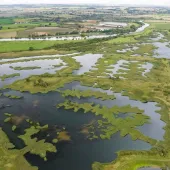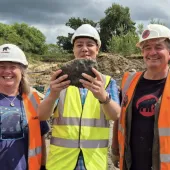Mesolithic Archaeology At North Park Farm Quarry

By Lucy Farr, Royal Holloway University of London
North Park Farm in Bletchingley, Surrey, is an operational sand quarry situated on the Folkestone Beds, less than 1km south of the North Downs chalk escarpment and about 2km north of the Lower Greensand (fig. 1).
Extension of the Quarry began in 2001, and in 2002 evaluation excavations conducted by Surrey County Archaeological Unit (SCAU) uncovered an assemblage of flint artefacts and associated features (hearths and pits) of Mesolithic age (c.11,500–6,800 calibrated years before present).
These discoveries proved that the site was highly significant in both its regional and national contexts and, as a consequence, more detailed excavations of the site were undertaken in 2005. These were carried out by SCAU and ArchaeoScape, Royal Holloway University of London, and were jointly funded by English Heritage (via the Aggregates Levy Sustainability Fund) and WBB Minerals, the quarry owners.
The 2005 excavations recovered many thousands of flint artefacts. These included obliquely truncated points typical of the earlier Mesolithic period (c.11,500–11,000 years before present), which were recovered along with high concentrations of flint debitage (fig. 2). This suggested that tool manufacture was taking place on site during this early phase of occupation.
Several later phases of activity, until around 6,800 years before present, are represented at the site by the presence of other age-diagnostic flint tools. Evidence of activity at around 9,000 years before present is particularly prevalent, suggested by the abundance of straight-backed bladelet microliths and associated debitage. Why the site was so favourable to repeated occupation over such a long period of time is not fully understood, although proximity to a good water source may have been an important factor.
Many fragments of charred hazelnut shell were also found at the site, indicating that hazelnuts formed an important part of the diet of the site inhabitants. Analysis of the charcoal from one of the hearth deposits has shown that both hazel and oak wood was burned as fuel, which, by association, suggests that these formed part of the local contemporary vegetation cover.
The flint artefacts and burnt plant remains found at the site will be dated using radiocarbon dating methods and the combination of this evidence will help in understanding precisely when, why, and for how long the site was occupied, and what natural resources were exploited during this time. Mesolithic sites that have an abundant charcoal assemblage for radiocarbon dating, together with good flint and organic assemblages, are very rare and the excavations at North Park Farm will provide some highly significant evidence to further enhance knowledge and understanding of the Mesolithic period in Britain.








